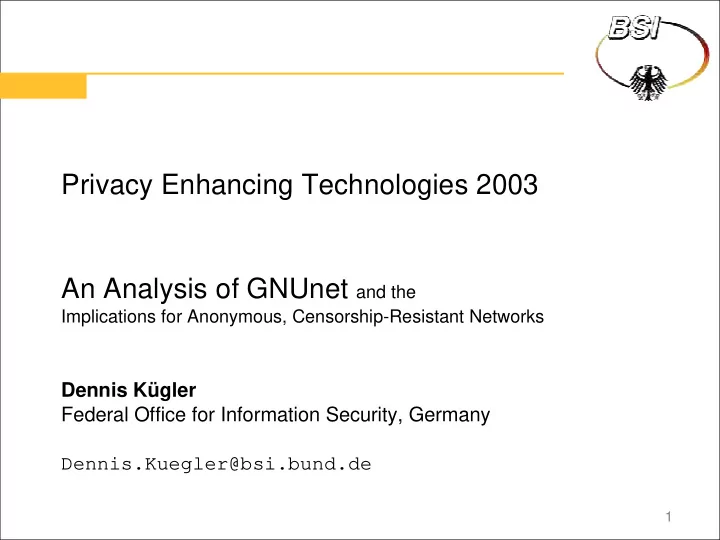

Privacy Enhancing Technologies 2003 An Analysis of GNUnet and the Implications for Anonymous, Censorship-Resistant Networks Dennis Kügler Federal Office for Information Security, Germany Dennis.Kuegler@bsi.bund.de 1
Anonymous, Censorship-Resistant Networks • Anonymous Peer-to-Peer Networks – Gnutella • Searching is relatively anonymous • Downloading is not anonymous • Censorship-Resistant Networks – Eternity Service • Distributed storage medium • Attack resistant • Anonymous, Censorship-Resistant Networks – Freenet – GNUnet 2
GNUnet: Obfuscated, Distributed Filesystem • Content Hash Key: [H(B),H(E H(B) (B))] – Content encryption: H(B) – Unambiguous filename: H(E H(B) (B)) • Content replication – Caching while delivering – Based on unambiguous filename • Searchability – Keywords 3
GNUnet: Peer-to-Peer MIX Network • Initiating node – Downloads content • Supplying nodes – Store content unencrypted • Intermediary nodes – Forward and cache encrypted content – Plausible deniability due to encryption • Economic model Query – Based on credit A B Priority=20 – Charge for queries c B =c B -20 - – Pay for responses 4
GNUnet Encoding • DBlocks DBlock DBlock ... DBlock – 1KB of the content – Content hash encrypted IBlock ... IBlock • IBlocks – CHKs of 25 DBlocks – Organized as tree – Content hash encrypted IBlock • RBlock – Description of the content RBlock – CHK of the root IBlock – Keyword encrypted 5
The Attacker Model • Attacker – Controls malicious nodes that behave correctly – Prepares dictionary of interesting keywords – Observes queries and responses • Queries for known keywords • Queries for known IBlocks and DBlocks • Responses containing known IBlocks and DBlocks • Goals – Uncover initiating node – Uncover supplying node(s): Censorship 6
Classical Attacks • Intersection Attack – Not all nodes participate in every (MIX) batch – Remove nodes not involved in routing linkable traffic • Predecessor Attack – Log identity of preceding node – All nodes are logged with equal probability – Initiator is logged more often • Both attacks are not discussed in GNUnet 7
The Shortcut Attack • Shortcuts do not hurt anonymity? – Remove nodes from anonymity set • Simplification – Guess preceding node – Verify guess afterwards A – No flooding required B Traffic C 8
Comments from the GNUnet Team • Only outbound traffic is considered for indirection! – Flooding requires credit • Shortcut attack may become even more powerful • Improved attack does not require flooding at all – Introduces additional intersection attack: DDoS • GNUnet doesn't setup static paths! – Every query is routed individually (with preference) • Route queries to nodes that have responded recently • Further queries are likely to use the shortcut – Attacks are more likely without static paths • Predecessor Attack • Triangulation & Encircling Attack 9
Triangulation & Encircling Attack 10
Censoring GNUnet • Rubber Hose Cryptanalysis – Censor infrequently requested content – Force nodes to remove content • Content Filtering – Censor frequently requested content – Legally enforced by law 11
Rubber Hose Cryptanalysis • Distance Attack – Determine nodes providing illegal content – Use low, increasing TTL to query nodes • GNUnet uses a different notion of TTLs – Relative Time: TTL – Absolute Time: TTL + T node 12
Routing Queries and Responses • Routing Table – Order entries by absolute time – Fixed number of entries • Discard only overstocked entries • Relative TTL may become negative! • Responses – Only after entry has been allocated long enough – Probably received response from another node • Intersection Attack – Linkability reduces deniability 13
Reverse Shortcut Attack • Reverse Shortcut Attack – Remove nodes from anonymity set • Simplification – Guess following node – Verify guess afterwards A – No flooding required B Traffic C 14
Content Filtering • Every block is unique identified by H(E H(B) (B)) • Censoring with licenses – Search for illegal content – Issue negative licenses for indexed content • Prohibits delivering the block – Issue positive license upon request otherwise • Allows delivering the block • Time restricted • Need not check content – Licenses are cached in GNUnet 15
Conclusion • We have presented some attacks on GNUnet – Linkability should be prevented at all costs – Setup paths as static as possible – Shortcut Attacks cannot be fixed easily • Economic model cannot replace trust • PGP Web of Trust? – Unique identifiers enable content filtering • Content filtering perhaps won't be realized • ...but it shows weaknesses in the concept • So, is GNUnet a sound approach? 16
Recommend
More recommend